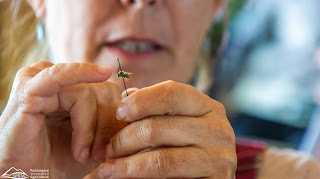Karla Salp
Communications
 |
| Dr. Karen Wright demonstrates how to net bees. |
Oh, did I mention they are also all volunteers?
These dedicated few are some of the first to join and volunteer
for a new project at the Washington State Department of Agriculture: the Washington
Bee Atlas. The goal of the project is to document the state's native bees
under the guidance of the WSDA’s first melittologist, Dr. Karen Wright.
Fun and fascinating – collecting native bees
 |
| Volunteers scout for bumblebees to catch and release with their insect nets. |
Next was learning to net specimens. As the morning was cool,
only bumble bees were out, which gave the participants an opportunity to
practice “catch and release” with the fuzzy fliers, learning the “figure eight
swoop” to ensure the specimens stayed in the net.
Now swinging the pros, volunteers next learned how to safely
“charge” the collection vials, net a bee, and put it in the vial for euthanization*
and preservation. Luckily, as the day warmed, the native bees became more
active and the group had luck finding and netting over 20 species from that
single location!
 |
| Logging plant types and location in iNaturalist |
Everyone was quick to pick up the basics needed to collect
bees. It was a fun and funky group to be around. Everyone was fascinated by the
bees they were finding, sometimes surprised when it came to pinning the bees
that bees they thought were the same while collecting proved to be different
when they took the time to pin and preserve them. Many stuck around to collect
at another location in the area on Sunday.
“Anyone can learn to collect native bees in less than a day.
Field work is a fun way to learn about the pollinators around us while
improving our collective knowledge about our bees and how they interact with
our environment,” Dr. Wright said.
Why native bees?
 |
| Dr. Wright shows how to situate the antennae when pinning so they don't accidentally break off later |
The map below shows known sightings of what is believed to
be about 600 species of native bees in Washington. It amounts to about one dot
per species believed to be in the state. In other words, we know almost nothing
about native bees as a whole and there are many large areas in the state with
no records at all.
The Washington Bee Atlas aims to change all that. Dr. Wright
is responsible not only for training the volunteers and running the program,
but for identifying all the bees that the volunteers collect as well.
 |
| Longhorned bee on flower |
A successful model
While the program is new to Washington, the Washington Bee
Atlas is not reinventing the wheel. The program is modeled on the Oregon Bee
Atlas, which has been in place for several years. In fact, the two programs are
collaborating. The Oregon Bee Atlas has developed such a thorough virtual training
that Washington’s Bee Atlas volunteers will be taking it as well.
Once fully trained and certified, the volunteers will be
able to collect under WSDA’s bee collection permits for the research project.
(Did you know you have to have permits to collect wildlife in Washington?)
Volunteering with the bee atlas
To participate in the Washington Bee Atlas, volunteers must
complete training to ensure they can properly identify and collect only native
bees.
 |
| Volunteers living their best life and swinging their insect nets! |
*Euthanization is a necessary part of this research
project as many species cannot be identified without examining the specimen
itself.
